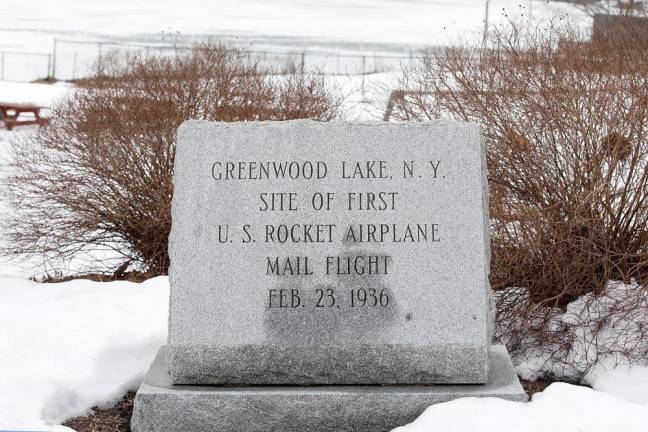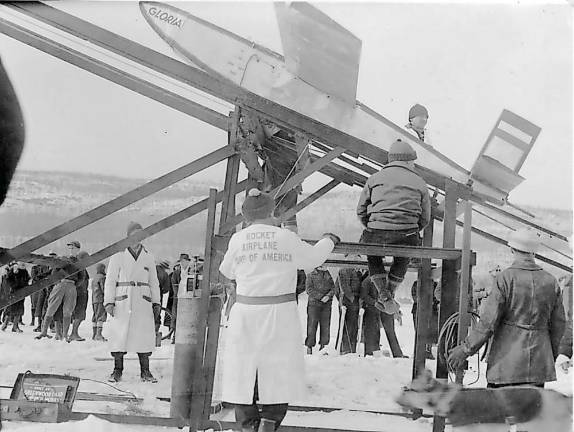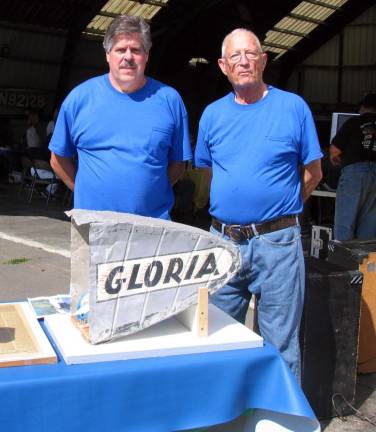First air mail rocket airplane launched from Greenwood Lake 85 years ago
Teteboro, N.J. Glorida, the original history-making rocket ship, was stored at Warwick Municipal Airport and now on splay at Teterboro Aviation Hall of Fame.



There’s a monument on the north shore of Greenwood Lake that reads, “Site of first U.S. Rocket Airplane Mail Flight Feb. 23, 1936.”
The story begins in 1935 when a stamp dealer, Frido W. Kessler, thought he could profit by having a mail-carrying rocket plane deliver a bag of mail bearing special stamps of his own design that he could then sell as valuable collectibles.
Kessler formed the Rocket Airplane Corp., and hired a recent German immigrant and rocket expert, Willy Ley, to design the rocket engine. A company in Long Island was commissioned to manufacture the airplane.
An interesting aside is that Ley had left Germany by using false documents to travel to London and then to America to escape the rule of the National Socialist German Workers Party (NAZI). Some of his ideas however, may have contributed to the development of their V-1 Buzz Bomb. Ley was a well-known science writer. And he also worked for American rocket development along with Wernher von Braun who actually did help design and develop the V-2 rocket for Germany during World War II.
Enter GWL Village Treasure John Schleich and his daughter, Gloria
Village of Greenwood Lake historian Wilbur Christman, the author of “Tales of Greenwood Lake,” wrote that the Village Treasurer in 1936, John Schleich, was also a stamp collector who knew Kessler. He suggested the lake, which borders on both New York and New Jersey, as a good site for an interstate rocket air mail flight. The location for the launch was to be at Sterling Forest near the state line. The day first planned was February 9, 1936.
The event was widely covered by major media and not every article reported the same facts. But Christman was an eye witness, most familiar with Greenwood Lake, and he reported that one of two aircraft that were on hand for the launch, was brought out to be christened “Gloria” by Gloria Schleich, 5, the daughter of John and Mildred Schleich.
The postmaster in Hewitt, N.J.
Due to freezing temperatures, the christening was difficult, the Champaign froze, and that was the beginning of a series of mishaps that included the failure of the liquid oxygen to ignite when Willy Ley, wearing an asbestos suit, tried to ignite it with a gas soaked rag. The launch, a disappointment earning much ridicule and criticism by the people on the bus and carloads of spectators as well as the cameramen, was then postponed for two weeks.
On Feb. 23, the media and the crowd gathered again and after a somewhat imperfect take-off the plane landed and skidded along, took off again, completed the 400-yard flight and finally crash landed in New Jersey.
Christman believes the flight lasted less than a minute. Then Ley took out the mail and loaded it on a sleigh, which the postmaster of Hewitt, New Jersey, took to his post office and stamped.
Mission accomplished and the stamp collectors were happy.
And then, 11 years ago ....
The whereabouts of that first rocket airplane remained uncertain but about 11 years ago a Greenwood Lake resident who had obtained possession of the original Gloria turned it over to the late Dave MacMillan, manager of the Warwick Municipal Airport. And it remained in the airport’s main hanger for several years.
MacMillan was also a trustee for the Teterboro Airport Aviation Hall of Fame museum and, with the help of friends and members of the Experimental Aircraft Association (EAA), restored and prepared the Gloria for its current display in an exhibit at the museum.
‘As significant as that first historic flight of the Wright brothers’
Although the short launch may seem almost comical today, a 1936 article in the well-respected magazine at that time, Popular Mechanics, stated: “Although it covered only a few hundred feet, the recent flight of the ‘Gloria,’ America’s first air mail rocket, at Greenwood Lake, may in time be considered as significant as that first historic flight of the Wright brothers at Kitty Hawk, which covered an even shorter distance.”
The article added that the flight had been termed a success because:
It proved certain basic principles important to the world-wide research program.
It proved a rocket motor can lift and propel a loaded airplane 50 times as heavy as the motor itself.
It also proved a rocket airplane can maintain a safe stability while in the air.
And that the principle of the reaction motor was basically sound.